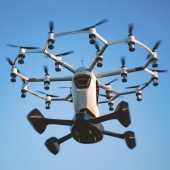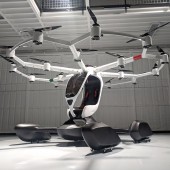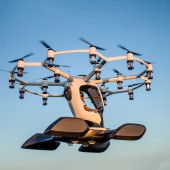Lift Aircraft HEXA Passenger Drone by Maform Design |
Home > Winners > #84268 |
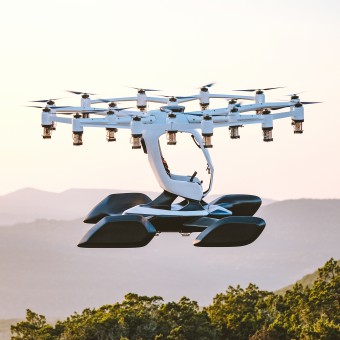 |
|
||||
| DESIGN DETAILS | |||||
| DESIGN NAME: Lift Aircraft HEXA PRIMARY FUNCTION: Passenger Drone INSPIRATION: Current battery technology limits the flight time of passenger drones to 20-40 minutes. This makes it difficult to sell expensive drones as means of personal transportation. This limits the advancement of drone technology in transportation. But what if we sold the flight experience? 20 minutes is more than enough to get a glimpse what it's like to be a pilot, and people would be happy to spend money on such an experience. This new business model can make it profitable in the short term to develop passenger drones. Lift addresses this newly found market, and to make it work, it needs a design that communicates aviation innovation, fun and reliability. UNIQUE PROPERTIES / PROJECT DESCRIPTION: LIFT Aircraft HEXA is an ultralight personal flying vehicle. Designed for aspirational pilots across the globe will enable anyone anywhere to fly, no pilot’s license required. It has 18 propellers, each driven by independent electric motors. Each motor is connected to a separate battery module. This design decision saves the weight of cables and makes the aircraft more redundant; an important feature to make the aircraft safe. The open canopy saves weight while providing a more enjoyable experience. OPERATION / FLOW / INTERACTION: Flight is booked using a mobile app. On the day of your first flight, you go through a short training, with a simulator session. If you succeed, you can proceed to the pre-flight check, where you have to do safety checks on the aircraft. This safety check is supervised by professional personnel. After pre-flight check you are free to start your flight. You can select between completely automatic flight where you act as a passenger, or pilot mode, where you control your flight with a joystick. After flight you do another check, then receive flight data and on-board video through the mobile app. PROJECT DURATION AND LOCATION: The project started in October 2017 in Budapest, the operational aircraft was introduced in March 2019 at SXSW festival in Austin, Texas, USA. |
PRODUCTION / REALIZATION TECHNOLOGY: Body is made of carbon fiber composite materials. Some joints are 3D printed from titan to provide extreme strength and durability with minimized weight. SPECIFICATIONS / TECHNICAL PROPERTIES: Szie: 4,6m x 4,6m x 2m 18 rotors, 4+1 floats, 1 paraschute, 18 separate batteries, 1 cabin, redundant flight controller, joystick and tablet for navigation TAGS: drone, aircraft, multirotor, future, mobility, airtaxi, pilot, flying, freedom, transportation RESEARCH ABSTRACT: Aircraft designs have to meet strict technical parameters, as weight, power and safety are crucial to create an operational aircraft. Best designs are the ones that can integrate all these factors in an appealing package. In this case, first the team defined the size and amount of motors/propellers. The next step was to ergonomically fit the pilot in the cabin. The legs of the aircraft are used as floats for water landing. During the design we used our own Challenge Mapping methodology, then continued with the concept design. The longest part was to finalize the design in 3D, with iterations based on simulation data to refine the mechanical qualities. To make the service better, we conducted a UX research for the booking app, and for the flight mode as well. Our goal was to provide 'pilot experience' to everyday people. CHALLENGE: The biggest challenge in aircraft design is to keep every part functional and lightweight, while making them look good. This particular aicraft addresses a new market, so it also has to look innovative and distinctive. To reach this, we used a high contrast design, emphasizing the special open canopy and general layout. In result, the aircraft is easily recognizable even from other passenger drones and has a cool yet friendly look. ADDED DATE: 2019-03-21 13:25:09 TEAM MEMBERS (3) : Robert Kovacs, Rita Honosi and Peter Molnar IMAGE CREDITS: Renderings: Maform Photos: Guinn Partners |
||||
| Visit the following page to learn more: https://www.maformdesign.com/references- |
|||||
| CLIENT/STUDIO/BRAND DETAILS | |
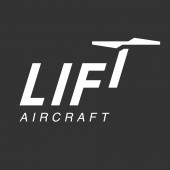 |
NAME: Lift Aircraft PROFILE: - |
| AWARD DETAILS | |
 |
Lift Aircraft Hexa Passenger Drone by Maform Design is Winner in Aerospace and Aircraft Design Category, 2018 - 2019.· Press Members: Login or Register to request an exclusive interview with Maform Design. · Click here to register inorder to view the profile and other works by Maform Design. |
| SOCIAL |
| + Add to Likes / Favorites | Send to My Email | Comment | Testimonials | View Press-Release | Press Kit |

